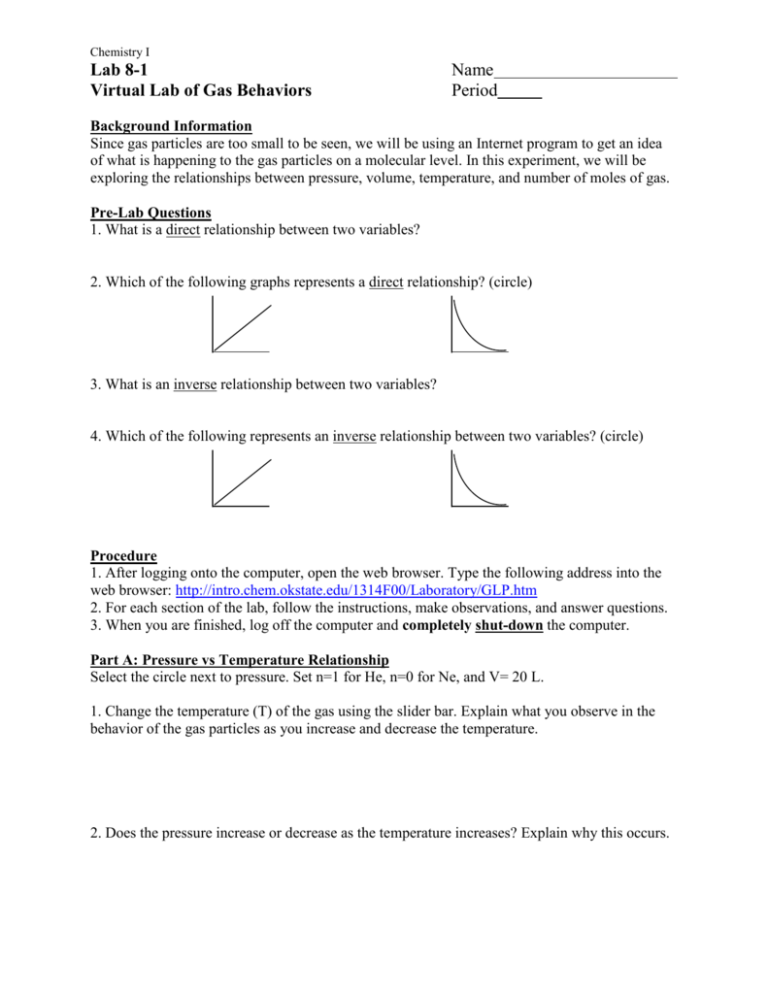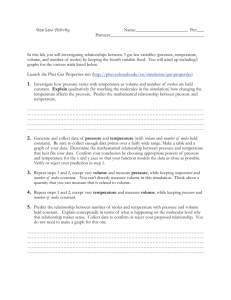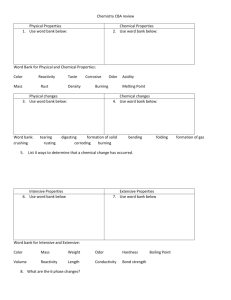Virtual Lab of Gas Behaviors
advertisement

Chemistry I Lab 8-1 Virtual Lab of Gas Behaviors Name Period Background Information Since gas particles are too small to be seen, we will be using an Internet program to get an idea of what is happening to the gas particles on a molecular level. In this experiment, we will be exploring the relationships between pressure, volume, temperature, and number of moles of gas. Pre-Lab Questions 1. What is a direct relationship between two variables? 2. Which of the following graphs represents a direct relationship? (circle) 3. What is an inverse relationship between two variables? 4. Which of the following represents an inverse relationship between two variables? (circle) Procedure 1. After logging onto the computer, open the web browser. Type the following address into the web browser: http://intro.chem.okstate.edu/1314F00/Laboratory/GLP.htm 2. For each section of the lab, follow the instructions, make observations, and answer questions. 3. When you are finished, log off the computer and completely shut-down the computer. Part A: Pressure vs Temperature Relationship Select the circle next to pressure. Set n=1 for He, n=0 for Ne, and V= 20 L. 1. Change the temperature (T) of the gas using the slider bar. Explain what you observe in the behavior of the gas particles as you increase and decrease the temperature. 2. Does the pressure increase or decrease as the temperature increases? Explain why this occurs. Chemistry I 3. Collect pressure and temperature readings at 6 different temperatures and record the values in the table below. Then graph your data points. (Don’t forget to label the axis and give your graph a title!) Pressure (atm) Temperature (K) 2.5 2 1.5 1 0.5 0 4. Describe your graph: 25 75 125 175 225 275 325 375 5. The relationship between pressure and temperature is ____________ (direct/inverse). Part B: Pressure vs Volume Relationship Select the circle next to pressure. Set n=1 for He, n=0 for Ne, and T=273 K. 6. Change volume of the gas using the slider bar. Explain what you observe in the behavior of the gas particles as you increase and decrease the volume. 7. Does the pressure increase or decrease as the volume decreases? Explain why this occurs. 8. Collect pressure and volume readings at 6 different volumes and record the values in the table below. Then graph your data points. (Don’t forget to label the axis and give your graph a title!) Pressure (atm) Volume (L) 2.5 20 16 2 121.5 8 1 40.5 9. Describe your graph: 0 0 0 25 5 7510125151752022525275303253537540 Volum e (L) 10. The relationship between pressure and volume is _______________ (direct/inverse). Chemistry I Part C: Pressure vs Number of Moles Relationship Select the circle next to pressure. Set n=0 for Ne, T=273 K, and V=20 L. Use the program to determine the relationship between pressure and number of moles of gas. 11. Does pressure increase or decrease as the number of moles is increased? _____________ 12. The relationship between pressure and number of moles is ___________ (direct/inverse). 13. Sketch a graph for the pressure versus number of moles relationship. (Label the axis and title!) Describe your graph: 14. Explain why pressure changes when the number of moles change. Part D: Volume vs Temperature Relationship Select the circle next to volume. Use the program to determine the relationship between volume and temperature. 15. Does the volume increase or decrease when the temperature is increased? ___________ 16. The relationship between volume and temperature is ______________ (direct/inverse). 17. Sketch a graph for the volume versus temperature relationship. (Label the axis and title!) Describe your graph: 18. Explain why volume changes when temperature changes while pressure remains constant. Conclusion 19. When the following variables increase, what happens to pressure? temperature volume moles 20. a. Which variable(s) [temp, vol, mol] have a direct relationship with pressure? b. Which variable(s) have an inverse relationship with pressure? 21. Based on your answers to #20, write an equation that relates pressure (P), temperature (T), volume (V), and moles (n).




